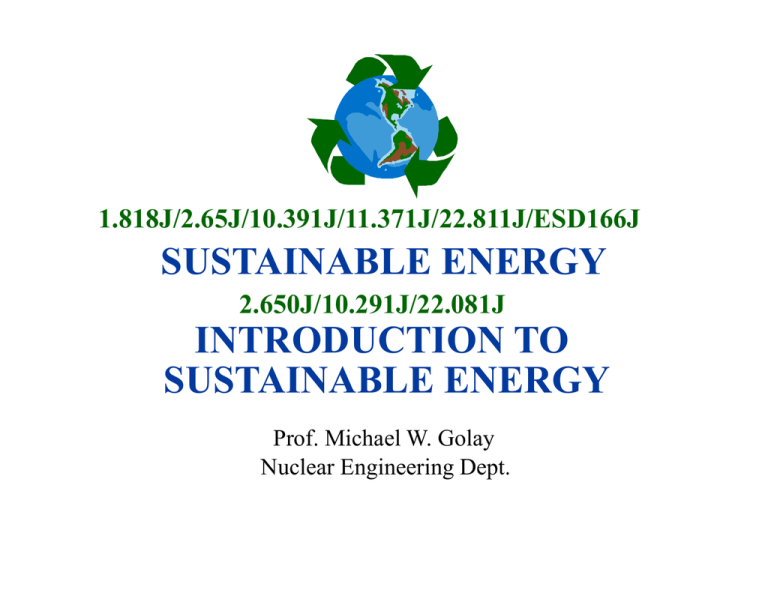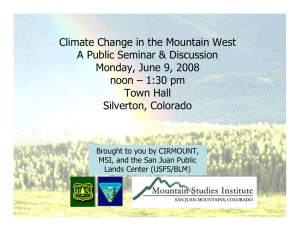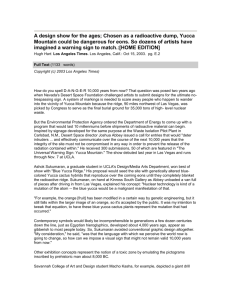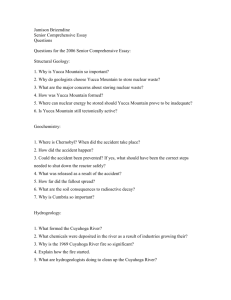Document 13444027
advertisement

1.818J/2.65J/10.391J/11.371J/22.811J/ESD166J SUSTAINABLE ENERGY 2.650J/10.291J/22.081J INTRODUCTION TO SUSTAINABLE ENERGY Prof. Michael W. Golay Nuclear Engineering Dept. NUCLEAR WASTES AND YUCCA MOUNTAIN 1 NUCLEAR WASTE Locations of Spent Nuclear Fuel and High-Level Radioactive Waste Defense Complex Clean-Up Commercial Spent Nuclear Fuel Support of Nonproliferation Initiatives, e.g. Disposal of DOE Foreign Research Reactor Spent Fuel Disposition of Naval Reactor Spent Nuclear Fuel Source: The Safety of a Repository at Yucca Mountain, USDOE, CRWM, June 2008. 2 SPENT NUCLEAR FUEL 39 states with nuclear waste Five DOE sites with nuclear waste Spent-fuel pools Dry cask storage Photos of spent fuel pool and dry cask storage from the U.S. Nuclear Regulatory Commission. 3 WASTE FORMS AND PACKAGES Source: The Safety of a Repository at Yucca Mountain, USDOE, CRWM, June 2008. 4 TRANSPORTATION CASK 5 Image by U.S. Department of Energy, Office of Civilian Radioactive Waste Management. TIMELINE FOR NUCLEAR WASTE DISPOSAL 1957 1982 1987 1992 Congress limited characterization to Yucca Mountain National Academy of Sciences (NAS) supported deep geologic disposal Congress passes Nuclear Waste Policy Act 2002 2008 President recommended and Congress approved Yucca Mountain Energy Policy Act sets Environmental Protection Agency (EPA) standard process 2010 2017 DOE shuts down Yucca Mountain License Application DOE scheduled to submit License Application DOE scheduled to begin receipt of spent nuclear fuel and high-level radioactive waste (will not happened) Image by MIT OpenCourseWare. 6 Humboldt County Eureka County Churchill County Storey Elko County Pershing County Lander County Washoe County YUCCA MOUNTAIN, NEVADA Carson City Douglas White Pine County Nye County Lyon Mineral County Esmeralda County Yucca Mountain Lincoln County Inyo County California Clark County Nellis Air Force Base NV Test Site Las Vegas Counties designated as affected units of local government 100 miles northwest of Las Vegas in Nye County Located on Western boundary of the Nevada Test Site, a U.S. Department of Energy (DOE) facility Image by MIT OpenCourseWare. 7 YUCCA MOUNTAIN SITE Source: The Safety of a Repository at Yucca Mountain, USDOE, CRWM, June 2008. 8 YUCCA MOUNTAIN YUCCA MOUNTAIN SUBSURFACE OVERVIEW SUBSURFACE OVERVIEW Surface 1,000 Feet North Portal South Portal Repository Level Water Table 1,000 Feet Protective Outer Barrier Mechanical Support Inner Barrier Permanent Waste Packages Various Permanent Waste Packages Access Tunnel Transporting Containers by Rail Remote Control Locomotive 9 9 Image by U.S. Office of Civilian Radioactive Waste Management. HYPOTHETICAL SCENARIOS • Volcanism! • Nominal! •Early defects! •Seismic! Source: U.S. Department of Energy. 10 Source: The Safety of a Repository at Yucca Mountain, USDOE, CRWM, June 2008. 11 CANISTER PLACED INSIDE WASTE PACKAGE Source: The Safety of a Repository at Yucca Mountain, USDOE, CRWM, June 2008. 12 LOCATION AND CHARACTERISTICS OF REASONABLE MAXIMALLY EXPOSED INIDVIDUAL AND FEATURES OF NATURAL SYSTEM BELOW REPOSITY THAT LIMIT MOVEMENT OF RADIONUCLIDES TO THAT LOCATION Source: The Safety of a Repository at Yucca Mountain, USDOE, CRWM, June 2008. 13 Yucca Mountain: Predicted average annual dose for 10,000 years Fig. F-17 in Draft Supplemental Environmental Impact Statement for a Geologic Repository at Yucca Mountain. U.S. Department of Energy, October 2007, DOE/EIS-0250F-S1D. 14 Yucca Mountain: Predicted median annual dose for 1,000,000 years Fig. F-17 in Draft Supplemental Environmental Impact Statement for a Geologic Repository at Yucca Mountain. U.S. Department of Energy, October 2007, DOE/EIS-0250F-S1D. 15 POSTCLOSURE PERFORMANCE RESULTS Source: The Safety of a Repository at Yucca Mountain, USDOE, CRWM, June 2008. 16 NUCLIDES OF INTEREST Appendix A in Bishop, William P., and Frank J. Miraglia, Jr. Environmental Survey of the Reprocessing and Waste Management Portions of the LWR Fuel Cycle. U.S. Nuclear Regulatory Commission, October 1976, NUREG-0116/WASH-1248 Supplement 1. 17 NUCLIDES OF INTEREST, cont’ Appendix A in Bishop, William P., and Frank J. Miraglia, Jr. Environmental Survey of the Reprocessing and Waste Management Portions of the LWR Fuel Cycle. U.S. Nuclear Regulatory Commission, October 1976, NUREG-0116/WASH-1248 Supplement 1. 18 BUILDUP OF REACTION PRODUCTS Images removed due to copyright restrictions. Please see Fig. 1, 2, 9-11 in Cohen, Bernard L. "The Disposal of Radioactive Wastes from Fission Reactors." Scientific American 236 (June 1977): 21-31. 19 DISPOSAL OPTIONS • • • • • Sub-Seabed Ice Sheets Space Deep Bore Holes Geologic repositories for storing highly radioactive materials have been chosen by the National Academy of Science in several assessments versus the alternative means of storage or disposal of highly radioactive materials. Source: S.A. Simonson, “Waste Technology Issues,” undated. 24 TECHNICAL PERFORMANCE CRITERIA • The bases for determining the performance of a geologic repository are established by regulations • The regulations establish numerical release limits that are presumed to be 1) Self consistent between regulating agencies NRC within 5 km of repository EPA beyond 5 km 2) Based upon equivalency of different radionuclide risks with regard to dose to man 3) Consistent with other societal risks Current basis is indirectly related to demonstrating a total system performance probability of less than one chance in 10 of causing 1000 excess deaths per 10,000 years Source: S.A. Simonson, “Waste Technology Issues,” undated. 25 TECHNICAL PERFORMANCE OF A GEOLOGIC REPOSITORY • In essence, the performance of a geologic repository system boils down • • • • to a very detailed risk assessment of all of the physical and processes that could occur that may result in releases of radionuclides to the environment using predictions extrapolated to many thousands of years into the future. First, Scenario of Likely Events Must be Identified For the Chosen Repository Location (Yucca Mountain) Natural, High Probability Natural Degradation of Engineered Barriers and Waste Forms Movement of Radionuclides in Ground Water or Air Natural, Low Probability Volcanism Earthquakes Human Intrusion Drilling Mining Source: S.A. Simonson, “Waste Technology Issues,” undated. 26 SUB-SYSTEM INVESTIGATIONS For Each of the Events, Predictive Models Must Be Developed Incorporating the Following Sub-System Models: • Natural Barriers and Repository Influences - Radionuclide Transport in Ground Water - Radionuclide Transport as Vapors and Gases - Water Infiltration into Repository • Engineered Barriers and Waste Forms Source: S.A. Simonson, “Waste Technology Issues,” undated. 27 HIGH-LEVEL WASTE DEFINITION: Wastes Arising from the Primary Decontamination Steps in the Reprocessing of Spent Fuel PRUEX Process: Nitric Acid Spent Fuel Shearing Dissolution High-Level Solvent Extraction Waste Uranium + Plutonium Uranium Uranium Plutonium Plutonium Separation Source: S.A. Simonson, “Waste Technology Issues,” undated. 28 TUTORIAL: SOLVENT EXTRACTION Reaction: UO 22 + (aq ) + 2NO −3 (aq ) + 2TB(org) ⇔ UO 2 ( NO 3 )2 ⋅ 2TBP (org ) Pu 4+ (aq) + 4NO 3− ( aq) + 2TB( org) ⇔ Pu ( NO 3 ) 4 ⋅ 2TBP ( org) Results in a Distribution of Uranium and Plutonium: concentration of i in organic phase Di concentration of i in the aqueous phase and a Net Separation of Uranium and Plutonium from the Fission Products: D product α= Dimpurity D’s for Uranium and Plutonium are Much Higher Than the Fission Products, Thus a Separation (large α) is Made at Greater Than 99% in One Pass of Solvent Extraction. Source: S.A. Simonson, “Waste Technology Issues,” undated. 29 REPROCESSING CONTINUED After Separation, Uranium is Separated from the Plutonium by Chemically Changing the Aqueous Solution and Repeating the Solvent Extraction Approximately 1% of the Spent Fuel is Plutonium of Which 70% is Fissile (7 g/kg spent fuel) ECONOMICS: Cost of Reprocessing Cost of Fuel Fabrication Energy Value of Plutonium Uranium Credit ~$1300/kg ~$ 350/kg ~$ 200/kg ~$ 60/kg Therefore, Marginal to Uneconomic to Reprocess at Current Facilities, Particularly When Uranium is Very Inexpensive Fission Products and Actinide Wastes are Sent for Processing Into Glass Logs for Permanent Disposal Source: S.A. Simonson, “Waste Technology Issues,” undated. 30 WHY GLASS? Historical Perspective of High-Level Waste Glass: • Natural Analogs • High Durability (10X better than spent fuel in retaining radionuclides • High Waste Loading (up to 30 wt% waste vs. 5% for spent fuel) • Predictability of Degradation Source: S.A. Simonson, “Waste Technology Issues,” undated. 31 NUCLEAR WASTE MANAGEMENT SYSTEM Image by U.S. Department of Energy. Source: S.A. Simonson, “Waste Technology Issues,” undated. 32 WASTE ISOLATION PILOT PLANT: ITS CAPACITY, ESTIMATED OPERATIONAL COST, AND ESTIMATED LIFETIME Fig. 2-3 in Complex Cleanup: The Environmental Legacy of Nuclear Weapons Production. U.S. Congress, Office of Technology Assessment, February 1991, OTA-O-484. 33 SOUTHERN NEVADA REGION Source: Fig. 1-5 in "Yucca Mountain Science and Engineering Report." U.S. Department of Energy, Office of Civilian Radioactive Waste Management (February 2002): DOE/RW-0539-1. 34 INTERESTED PARTIES Image by U.S. Department of Energy. Source: S.A. Simonson, “Waste Technology Issues,” undated. 35 OBSERVATIONS • • • • • • • Complex, First-of-a-Kind Project Public Acceptance Dominates Numerous Oversight Entities Incredible Meetings Schedule Fire Drills Dominate Strategic Planning Radioactive Waste People are Competent and Hardworking DOE Bureaucracy is a Major Challenge Source: S.A. Simonson, “Waste Technology Issues,” undated. 36 OBSERVATIONS (Continued) • • • • • • The M&O Welcomed by DOE/Community High Expectations Large, High Visibility Tasks Being Assigned M&O Identity and Team Integration is Good TRW/Team Identity and Reputation Will Be Applied M&O is Viewed as Different Broadly capable Mission/goal oriented Experienced/up-to-speed Not a support contractor Source: S.A. Simonson, “Waste Technology Issues,” undated. 37 EXPLORATORY STUDIES FACILITY NOTE: This is pictorial only and not drawn to scale. Source: S.A. Simonson, “Waste Technology Issues,” undated. Slide 7 in Petrie, Edgar H. "Exploratory Shaft Facility Alternatives Study - Resumption of Design Activities." U.S. Department of Energy, Office of Civilian Radioactive Waste Management, March 7, 1991. 38 CANISTERS 39 YUCCA MOUNTAIN COUNTRYSIDE 40 YUCCA MOUNTAIN COUNTRYSIDE 41 YUCCA MOUNTAIN COUNTRYSIDE 42 YUCCAS AT YUCCA MOUNTAIN 43 YUCCA MOUNTAIN COUNTRYSIDE, METEOROLOGICAL STATION 44 YUCCA MOUNTAIN COUNTRYSIDE 45 YUCCA MOUNTAIN TUNNEL ENTRANCE, RAIL ENGINE 46 YUCCA MOUNTAIN EXCAVATION PILE 47 YUCCA MOUNTAIN ENTRANCE 48 YUCCA MOUNTAIN ENTRANCE 49 YUCCA MOUNTAIN TUNNEL 50 YUCCA MOUNTAIN TUNNEL 51 YUCCA MOUNTAIN TUNNEL 52 NPR IN ACTION 53 TUNNEL HEATING MEASUREMENT 54 TUNNEL HEATING MEASUREMENT, VISITING ENGINEER 55 TUNNEL HEATING MEASUREMENT 56 TUNNEL HEATING MEASUREMENT, THERMAL PROBES 57 TUNNEL HEATING MEASUREMENT, CHEMICAL PROBES 58 YUCCA MOUNTAIN WATER SUPPLY, SYMBOL OF FEDERAL-STATE RELATIONSHIP 59 MIT OpenCourseWare http://ocw.mit.edu 22.081J / 2.650J / 10.291J / 1.818J / 2.65J / 10.391J / 11.371J / 22.811J / ESD.166J Introduction to Sustainable Energy Fall 2010 For information about citing these materials or our Terms of Use, visit: http://ocw.mit.edu/terms.





